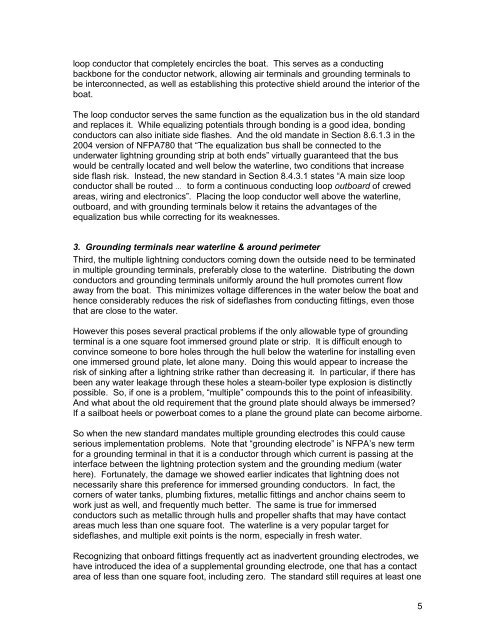A New Concept for Lightning Protection of Boats - Marine Lightning ...
A New Concept for Lightning Protection of Boats - Marine Lightning ...
A New Concept for Lightning Protection of Boats - Marine Lightning ...
Create successful ePaper yourself
Turn your PDF publications into a flip-book with our unique Google optimized e-Paper software.
loop conductor that completely encircles the boat. This serves as a conductingbackbone <strong>for</strong> the conductor network, allowing air terminals and grounding terminals tobe interconnected, as well as establishing this protective shield around the interior <strong>of</strong> theboat.The loop conductor serves the same function as the equalization bus in the old standardand replaces it. While equalizing potentials through bonding is a good idea, bondingconductors can also initiate side flashes. And the old mandate in Section 8.6.1.3 in the2004 version <strong>of</strong> NFPA780 that “The equalization bus shall be connected to theunderwater lightning grounding strip at both ends” virtually guaranteed that the buswould be centrally located and well below the waterline, two conditions that increaseside flash risk. Instead, the new standard in Section 8.4.3.1 states “A main size loopconductor shall be routed … to <strong>for</strong>m a continuous conducting loop outboard <strong>of</strong> crewedareas, wiring and electronics”. Placing the loop conductor well above the waterline,outboard, and with grounding terminals below it retains the advantages <strong>of</strong> theequalization bus while correcting <strong>for</strong> its weaknesses.3. Grounding terminals near waterline & around perimeterThird, the multiple lightning conductors coming down the outside need to be terminatedin multiple grounding terminals, preferably close to the waterline. Distributing the downconductors and grounding terminals uni<strong>for</strong>mly around the hull promotes current flowaway from the boat. This minimizes voltage differences in the water below the boat andhence considerably reduces the risk <strong>of</strong> sideflashes from conducting fittings, even thosethat are close to the water.However this poses several practical problems if the only allowable type <strong>of</strong> groundingterminal is a one square foot immersed ground plate or strip. It is difficult enough toconvince someone to bore holes through the hull below the waterline <strong>for</strong> installing evenone immersed ground plate, let alone many. Doing this would appear to increase therisk <strong>of</strong> sinking after a lightning strike rather than decreasing it. In particular, if there hasbeen any water leakage through these holes a steam-boiler type explosion is distinctlypossible. So, if one is a problem, “multiple” compounds this to the point <strong>of</strong> infeasibility.And what about the old requirement that the ground plate should always be immersed?If a sailboat heels or powerboat comes to a plane the ground plate can become airborne.So when the new standard mandates multiple grounding electrodes this could causeserious implementation problems. Note that “grounding electrode” is NFPA’s new term<strong>for</strong> a grounding terminal in that it is a conductor through which current is passing at theinterface between the lightning protection system and the grounding medium (waterhere). Fortunately, the damage we showed earlier indicates that lightning does notnecessarily share this preference <strong>for</strong> immersed grounding conductors. In fact, thecorners <strong>of</strong> water tanks, plumbing fixtures, metallic fittings and anchor chains seem towork just as well, and frequently much better. The same is true <strong>for</strong> immersedconductors such as metallic through hulls and propeller shafts that may have contactareas much less than one square foot. The waterline is a very popular target <strong>for</strong>sideflashes, and multiple exit points is the norm, especially in fresh water.Recognizing that onboard fittings frequently act as inadvertent grounding electrodes, wehave introduced the idea <strong>of</strong> a supplemental grounding electrode, one that has a contactarea <strong>of</strong> less than one square foot, including zero. The standard still requires at least one5
















